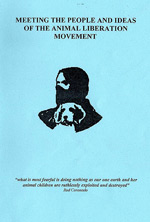» Next Entries
The Archives
-
One-off publications
Meeting the People and Ideas of the Animal Liberation Movement
06.16.11 | PermalinkMeeting the People and Ideas of the Animal Liberation Movement (Publication date unknown, Amsterdam, Netherlands)
Before the age of “re-tweeting,” “re-blogging,” and “sharing” other people’s postings on the internet, zinester culture had its own form of helping spread information further afield from its initial distribution. DIY publishers would extract and reprint entire articles in their own zines which they had read first in other publications. In the case of this publication, activists in the Netherlands took some of the best articles from early issues of No Compromise and compiled them into this short, informative, and inspiring little booklet. Ideas which had previously been shared in the United States thus became available abroad, and the old information grapevine which relied on print was expanded just a little further. This is a good read with a mouthful of a title!
…
-
From the antis
The People’s Agenda
06.06.11 | PermalinkThe People’s Agenda (Random issues, 1992-1993, Washington, DC, USA)
The People’s Agenda was the official newsletter of Putting People First, an industry front group that pretended to represent good ol’ fashioned American animal abuse. In actuality, they were heavily funded by the industries they defended, from fur farmers to meat packers. Their PR angle involved the typical lies about caring for animal welfare, placing human rights above those of plants and animals, and conflating animal liberation philosophy alternately as a new age religion or an extension of Marxism. At times the articles contained herein make for hilarious examples of dirty journalism, and other times they provide us with lessons about how our actions can be spun and used against us. Interestingly, there are also underground actions reported in the People’s Agenda that are either hoaxes, or real actions gone wrong that never received coverage in AR publications.
Putting People First was one of many anti-animal rights organizations that prospered during the 80s and 90s. While many of these groups are still around, most notably the Center for Consumer Freedom, their heyday seems to have passed. It would be a mistake to believe that decline occurred because these groups lost the support of a large segment of our society. Actions taken in opposition to human supremacist politics are still widely opposed by those who enjoy the position of power that they hold over non-humans. The real reason that these groups are no longer as plentiful is that our movement isn’t the threat that it once was. As we come out of the chilling effect created by the SHAC 7 conviction, you can bet that publications like this will become popular once more. Combating their press and political strategy will be crucial to our progress, and familiarizing ourselves with their past actions will go a long way towards defeating them in the future.




…
-
Periodicals, Underground
Underground #4-6
06.05.11 | PermalinkUnderground 4-6 (1996, Toronto, Ontario, Canada.)
As Underground magazine continued its run into 1996, the movement was once again in a state of internal dispute. The wave of FBI investigations and grand jury harassment earlier in the decade had put Rod Coronado behind bars. Sadly, an embarrassing moment in our history occurred when a small group of activists, including Rod’s long time friend and former housemate Jonathan Paul, called for support to be pulled from Rod. Their reasons were many, but largely centered around Rod’s desire to make the choices that effected his own defense. Jonathan and Rod later patched up their differences, but for many years those two great practitioners of direct action warred back and forth in the pages of this and other publications, which proved a waste of effort, time, and newsprint.
Luckily for nonhumans, 1996 was also a year that saw a tremendous upswing in resistance on their behalf. Notably, fur farm raids became common occurrences throughout the world. This was the year that saw the release of the infamous first edition of The Final Nail, a publication that gave addresses of fur farms and explained how to raid them. Excerpts appeared in Underground, and subscribers received free copies. Every issue throughout this period detailed the pressure being exerted on the fur farming industry, and proved that Rod’s imprisonment and the ensuing movement drama didn’t put the struggle for fur bearing animals in an early grave.
Underground also contained plenty of letters, news clippings, and short articles. Self criticism, analysis of movement building, targeting, press relations, and other strategic improvements are, sadly, largely absent. Still, the magazine provides one of the best glimpses into the way the ALF worked in North America in the 90s, which is why we will be posting every issue online, for free, by the middle of this month. Animal liberation history is for people, not profit!
Also see Underground 1-3 and Underground 7-9 and Underground 10-13 and Underground 14-15 and the final rare issue, Underground 16.
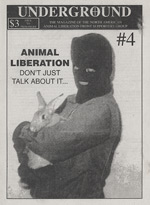
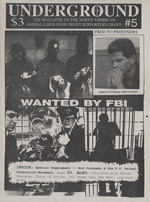

…
-
Periodicals
Out of the Cages #6-9
05.19.11 | PermalinkOut of the Cages #6 – 9 (1993-1994. Santa Cruz, CA. USA)
Out of the Cages is a wonderful magazine that filled an important niche in the pre-internet, pre-No Compromise 90s. As the main west coast publication of its time, it had a link to the 80s glory days that ran deep in the area it was printed. Santa Cruz had been the home of early US hunt saboteurs and the earliest cooperation between animal rights activists and Earth First! took place there. Rod Coronado, Jonathan Paul, and other early AR radicals called it home. This proximity to history gave the magazine a much different tone than Holocaust, or Dressed in Black, and unlike Militant Vegan, the group publishing OOTC were above ground liberationists, accessible for correspondence and submissions. This meant that the zine was always filled with fresh perspectives, letters, and debate, and that eventually groups from across the country got in touch to share ideas and announce their campaigns.
Conflict Gypsy would very much like a complete set of Out of the Cages. If you have any please contact us at conflictgypsy {{at}} gmail ((dot)) com


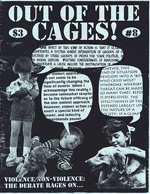

…
-
One-off publications
How to Sink Whalers, Driftnetters, and Other Environmentally Destructive Ships
05.15.11 | PermalinkHow to Sink Whalers, Driftnetters, and Other Environmentally Destructive Ships (1993, Chica, CA. USA)
The scuttling of ships used to harm the ocean has a long and proud tradition in our movement. Classically, large boats were sunk with limpet mines attached magnetically to their hulls, but another method became popular in 1986 when David Howitt and Rod Coronado sank two boats in harbor in Iceland by opening the sea water intake valves and allowing the ocean to claim these destructive vessels. Their method, originally published as an epilogue in later editions of Dave Foreman and Bill Haywood’s Ecodefense, was later excerpted for publication in this little zine format gem.
…
-
One-off publications
The Liberator
04.27.11 | PermalinkThe Liberator (1988, San Bernadino, CA. USA.)
In the 1970s, a small group of activists in England decided that animal abuse was so intrinsic to their society, and so protected by the courts and law enforcement, that anonymous, illegal activity was the only surefire way to directly prevent the horrors taking place in slaughterhouses, labs, and killing fields. They began to take the personal initiative to raid and sabotage places where the victimization of animals occurred, but how could they spread their message and tactics? With mainstream media treating them either as misguided nutcases or vicious criminals, and with national animal organizations disavowing their actions, they needed a mechanism to defend their tactics and share their views. The answer was the Animal Liberation Supporters Group, more commonly known as “The SG.” The SG soon took on the responsibility of printing newsletters, conducting press interviews, and raising funds and support for imprisoned activists. Soon, other supporters groups blossomed internationally, and eventually one took off in a small town in Southern California.
The Liberator was a publication of the Animal Liberation Front Support Group of America, an organization with a storied history that included FBI harassment, raids, and internal conflict. This inaugural issue was largely produced by Rod Coronado and Todd Meszaros, and the aesthetics of the issue reflect a bit of the punk influence that the two of them embraced. The design is busy, but also packed with information, press clipping, letters, debates, a timeline of US actions, and historically important letters from figures such as ALF co-founder Ronnie Lee. The centerfold is gorgeous, and it, and many of the other images contained inside were heavily borrowed and reprinted by other magazines.
The mission of the ALF SG of America was to vocally support and defend the ALF, to unify supporters of underground animal activism, to educate the public as to need and rationale of direct action, to encourage implementation of clandestine tactics, to provide a legal defense fund for imprisoned or arrested ALF activists, and to raise funds for all of the above. They did this at a time when dozens of labs across the country were being raided, thousands of people were protesting for animal rights, and the US seemed to be on the cusp of a mass movement for non-humans. The Liberator documented these efforts and is a classic piece of animal liberation history.
…
-
Periodicals
Resistance
04.10.11 | PermalinkResistance Volume 1 #1-4, Volume 2 #1 (1999-2001. Portland, OR. USA)
Before Portland became famous for its eccentricities and vegan mini-malls, it used to be known as one of the west coast’s most active centers for direct action oriented environmental, animal, and human rights activism. Famously referred to as “little Beirut,” by the George H.W. Bush administration, Portland was the home of peace-punk bands, eco-saboteurs, and anti-government riots. Then, strangely enough, it became a hotbed of pacifism in the mid-90s thanks to the efforts of… wait for it… Craig Rosebraugh.
Craig eventually became known internationally for his support of political violence and ecotage, but for a few years he was an advocate of Gandhian nonviolence. After participating in several voluntary arrest actions, he co-founded the group Liberation Collective in 1996 as a blanket organization meant to tackle a wide variety of social ills. The group was a springboard for many well known activists, and planned a number of media spectacles across the United States, from Buy Nothing Day car smash-em-ups in busy downtown streets to the cross country Primate Freedom Tour. (The PFT was credited in large part to a group called Coalition to End Primate Experiments, but the greater part of the organizing was done by LibCo members.)
After the failure of attempts such as One Struggle to document a broad movement for ecological sanity and justice for all life, Liberation Collective took up the torch and released the first issue of Resistance. The inaugural issue was unlike any other in the series though. The main forces behind the publication, Craig and Leslie James Pickering, had politics that were no longer meshing well with the rest of the group. Liberation Collective was falling apart due to a number of factors, and ultimately LJ and Craig struck out on their own, founding the North American Earth Liberation Front Press Office and continuing the Resistance project as a newsletter of their new organization.
The third issue of Resistance launched what was to become the best source of information for a rapidly expanding underground movement. The Earth Liberation Front was becoming active across the United States, but supportive coverage could be difficult to find. Even the Earth First! Journal wasn’t always willing to support the large scale arson attacks of the ELF, and when they did they lost membership. (Famously, Julia Butterfly left Earth First! after the Journal gave positive coverage to the Vail arson.) Resistance, however, published nearly every ELF communique unedited, and covered the multiple federal investigations into the groups actions. Activists seeking a better knowledge of the events leading to the green scare and “Operation Backfire” arrests would do well to start by reading the early volumes of Resistance.





…
-
Most Popular, One-off publications
Memories of Freedom
03.19.11 | PermalinkMemories of Freedom (1997? Tucson, AZ. USA)
This was the most inspiring publication I read in the early days of my activism, and remains a gorgeously written account of a small number of young people fighting from underground to make a change. The stories contained herein have become legend, and that sadly is the worst thing about this otherwise classic text.
Originally credited as being written by anonymous members of the “Western Wildlife Unit,” Rod Coronado later admitted being the author. The story was told from his perspective, and while he passionately believed his version of events, there were facts that he was unaware of during the time that the book was written. His recollections are also through a lens of spirituality which bears mention here. Religious fervor tends to skew memory so that events reflect belief rather than reality.
Since the publication of Memories of Freedom, a more journalistic study of the events described in the book has been completed. Ultimately, that study became the book Operation Bite Back by Dean Kuipers. After extensive research and interviews, it became clear that some of the events described in Memories were less spectacular than originally perceived by the author. For example, one raid at the USU Predator Research Facility is portrayed as a heart-warming victory wherein the raiders speak to the coyotes and are assisted in entering the building by the noise raised by the animal they came to save. In reality, the coyotes were highly domesticated and territorial. After being released many of them attacked each other, and required veterinary attention. One was shot, and another killed in the fighting. All survivors were recaptured, and the damage done to the research was minimal.
Memories of Freedom remains the best insider picture of the Animal Liberation Front, but it, like all propaganda, should be read with a critical and skeptical eye. While the stories are beautiful and told from the honest memories of Rod Coronado, they are incomplete in the way that all auto-biographies are. We can only learn from our errors when we are honest about them, and I hope that young activists will look further when they research these and other old publications.
…
-
Most Popular, Periodicals
Stronghearts
03.14.11 | PermalinkIn 1995, Rod Coronado was serving a prison sentence for conspiracy charges related to an arson at Michigan State University. During his incarceration he produced four issues of a wonderful cut and paste style zine called Strong Hearts.
I was a young anarchist living in Portland at the time, and obsessed with the writings of Alexander Berkman. Most notably, I was intrigued with his secretly produced prison publication known as Prison Blossoms. Written on various scraps of paper and clandestinely distributed to both prisoners and the outside world, there were no known copies available. One day, while discussing what treasures might have been held on those random bits of smuggled pulp, someone told me about Strong Hearts. I picked up a copy of the first issue at Reading Frenzy and felt like this time around I hadn’t missed out.
Rod’s writing was passionate and avoided much of the juvenile machismo that was endemic to the militant animal rights movement at the time. He bristled at single issue politics, and the magazine covered a spectrum of analysis, news, and tactics in the struggles for wilderness, wild life, women, and indigenous peoples. He was a prisoner, but the cluttered pages of Strong Hearts shined with the cheerful beauty of his intelligence and attitude. As each new issue came out those of us on the outside got a clearer picture of the author. We knew he was a warrior in the best sense of the word, and life behind bars had not yet taken his spirit of resistance.
Time has marched on, and whereas most of the old AR zines from this era seem dated, Strong Hearts largely holds up. The first hand accounts of the sinking of whaling ships, liberations of captive animals, and other direct actions are timeless, and when I fault much of anything about the rest of the writings, it is foremost their legibility. Most issues and articles managed to be inspiring without being fanatical, educational without being preachy, and accessible without being simplistic. Typically I would spend more time analyzing a zine like this, but Strong Hearts speaks for itself. I hope it brings as much to your life as it brought to mine.
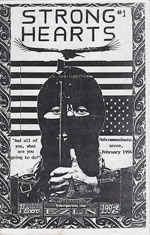

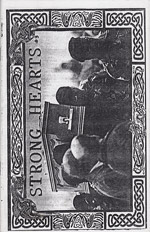

…
-
Periodicals
The Militant Vegan
03.14.11 | PermalinkThe Militant Vegan 1-8 (January 1993 – March 1995. USA.)
Militant Vegan was an anonymously produced zine that ran for 8 issues between 1993 and 1995. The final issue was never printed by the team who produced the magazine, instead the files were distributed online. Due to the poor quality of modems and low usage of the internet at the time the issue was mostly lost to history. Other things contributed to the mag’s obscurity as well. For example- there was no address to order the magazine from. Instead, originals were distributed to some animal rights groups and it was requested that they make copies, and that the readers of those copies make further copies to distribute to activists. Since the publication already relied on much cutting and pasting this method of circulation resulted in heavy generation loss of images, and obtaining readable copies wasn’t always easy. Even activists who were heavily involved in the movement at that time never saw every issue. Conflict Gypsy was luckily able to track down a complete set, including the rare eighth and final dispatch.
Printed in starkly contrasted black and white, and dressed in over-the-top, macho imagery, Militant Vegan’s primary purpose was to publicize actions and news ignored by mainstream movement publications. Otherwise, the philosophy of the magazine was vague. It was pleasant to read a brief denunciation of the sexism and homophobia advocated by the “Hardline movement” in MV’s early issues, but elsewhere there was less clarity. For example, ALF guidelines prohibiting violence appeared alongside statements celebrating the poisoning of animal products left on store shelves. (These actions turned out to be hoaxes, and no one was actually poisoned.) Frequent reminders that the publishers didn’t wish to encourage illegal activity appeared alongside instructions on how to do exactly that. And despite the angry condemnation of speciesism, cops are still referred to as pigs in a page reprinted from Defiance #1. The rhetoric could be ugly and was generally unlikely to convince people that direct action was an ethical tactic that provided the movement a way forward.
Despite all of this there was nothing quite like Militant Vegan at the time that it was published, and it documented the rise of a new era of grassroots activism in the United States prior to the publication of No Compromise. For the lucky few who could obtain copies, MV brought news of groups like Student Environmental Action League, Coalition to Abolish the Fur Trade, and Animal Defense League into their homes when glossy magazines like Animal’s Agenda did not. After a sharp dip in the number of underground actions in the earlier part of the 90s, Militant Vegan was a good source of information on the new trend towards smaller scale economic sabotage. Occasionally a well written original article appeared, and seeing press clippings from former radical (and current HSUS honcho) JP Goodwin’s convictions for sabotage remains amusing. Finally, the letters from prisoners were at times inspiring, and the coverage of Rod Coronado’s case from arrest to conviction is essential reading.
In total, Militant Vegan was a product of its time, written by amateurs who saw a niche and decided to fill it. It remains one of the only insider perspectives from that period of underground and radical grassroots animal liberation activism.








…
» Next Entries
